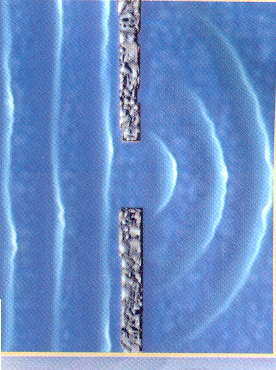
When the waves came hindered by obstacles such as a breakwater or island, the waves will be turned on around the end of the barrier and entered the protected area behind it. Diffraction occurs when there are differences in the sharp wave energy along wave crests. At first the conditions in the protected area barrier quiet enough (there are no waves), as a wave across the barrier. Waters far from the barrier will have more energy (initial wave energy) than the waters behind the barrier which had been quiet (no energy because there are no waves), the energy transfer process occurs at the crest length to the area of protected coastal buildings.
Transfer energy to the establishment of protected areas causing waves in the area, though not as big waves outside the protected areas. Crest lines in the back and have turned obstacles arc shape with its center at the end of the obstacle. Considered that the water depth is constant. If not, then it also occurs in addition to the diffraction wave refraction. Usually reduced wave height along the crest toward the protected area.
When the wave went through a structure there will be a transfer of wave energy in line with the peak of the wave inside the structure. Concentration of energy density will lead to periods of higher waves of the spectrum. With KD to determine the distance from the wave period and direction, one can evaluate the characteristics of the wave spectrum at a point in
areas protected by coastal structures in order to plan the wave damping structure.
Transfer energy to the establishment of protected areas causing waves in the area, though not as big waves outside the protected areas. Crest lines in the back and have turned obstacles arc shape with its center at the end of the obstacle. Considered that the water depth is constant. If not, then it also occurs in addition to the diffraction wave refraction. Usually reduced wave height along the crest toward the protected area.
When the wave went through a structure there will be a transfer of wave energy in line with the peak of the wave inside the structure. Concentration of energy density will lead to periods of higher waves of the spectrum. With KD to determine the distance from the wave period and direction, one can evaluate the characteristics of the wave spectrum at a point in
areas protected by coastal structures in order to plan the wave damping structure.
No comments:
Post a Comment